Diverse projects in terms of size, approaches, and locations offer an opportunity to reflect on the direction the architecture world might take in the coming year. We’ve identified ten architectural marvels, some characterized by extreme innovation, others undergoing restoration.
Discover more in this article.
Egyptian Museum of Turin | Studio OMA

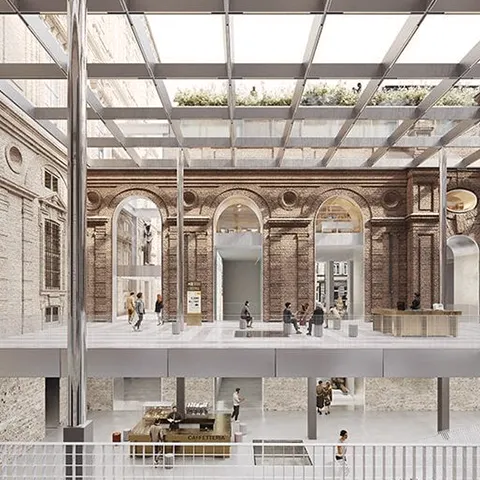
CREDITS TO OMA
The Egyptian Museum of Turin, erected in 1824 within the Collegio dei Nobili, is about to do an architectural revolution. Thanks to the visionary project conceived by Studio OMA in collaboration with David Gianotten, Andreas Karavanas, Andrea Tabocchini Architecture, T-Studio, and Andrea Longhi, the iconic structure will undergo a radical redesign, opening itself to the city and its community. Central to the innovation are the creation of Piazza Egizia, an enchanting, covered courtyard destined to become a lively public space, and six interconnected “urban rooms,” designed to host a variety of activities and attractions. Openings along the museum’s facade will invite visitors in, while the transparent covering of Piazza Egizia not only creates a bright and welcoming environment but also serves important eco-sustainable functions. This transformation not only strengthens the bond between the museum and the city but also offers a new inclusive cultural experience for all, with permanent exhibitions and events accessible to all audiences.
Education Center by Kirimoto | Florence

CREDITS TO ALVISI KIRIMOTO
The Andrea Bocelli Foundation and the Alvisi Kirimoto studio join forces once again to create an educational and laboratory center within the Meyer pediatric hospital in Florence. Located in the northern part of the hospital area, the new building will stand out for its independent shape and slight inclination, creating a space entirely dedicated to children. Inside, a structure resembling a “leaf,” conceived by Massimo Alvisi, will host a variety of functions, promoting lightness and brightness. At the center of the building will be an oval-shaped musical laboratory in the form of a carillon, representing the project’s heart. As is typical in Alvisi Kirimoto’s projects, technical complexity will be hidden behind transparent surfaces supported by lightweight metal elements, creating a bright and welcoming environment.
Restoration of Notre Dame de Paris
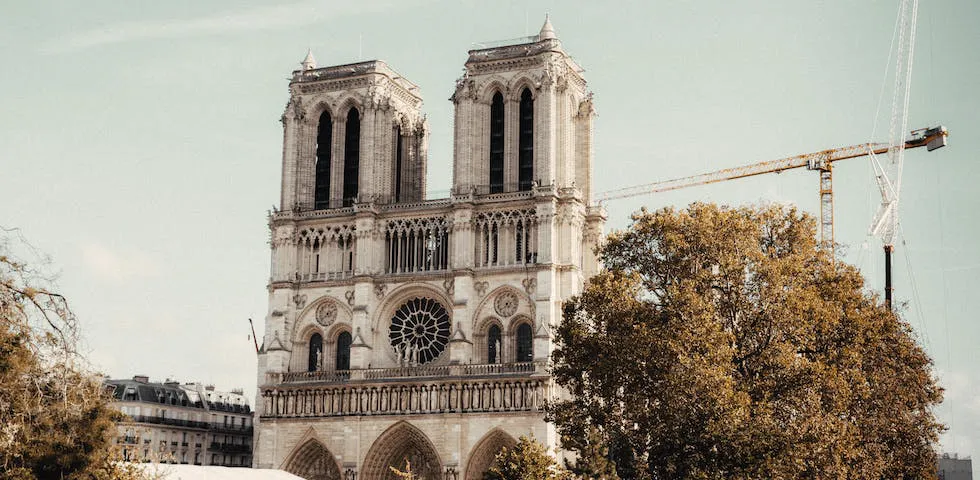
Emmanuel Macron has announced that the Notre-Dame Cathedral in Paris will reopen to the public by 2024, with hopes for this to happen by December 8th. The restoration works, which began only in 2022 due to the pandemic and archaeological discoveries, focus on restoring the roof and spire according to the original design by Eugène Viollet-le-Duc from 1859. Despite controversies surrounding a modernization project, supported by Macron but abandoned after protests, the restoration is proceeding with over 800 million euros, including contributions from François Pinault and Bernard Arnault.
New Sub-Central Library by Snøhetta | Beijing, China
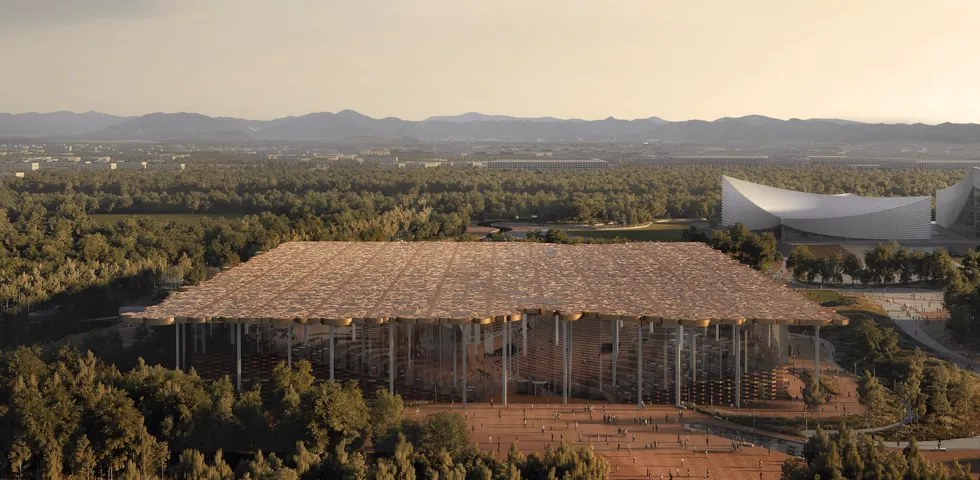
CREDITS TO PLOMP
The new Sub-Central Library in Beijing will distinguish itself as a cutting-edge hub for learning and cultural exchange. Designed by Snøhetta after an international competition in 2018, the structure incorporates advanced technology and sustainable design. The self-supporting glass façade, unique in China, reflects architectural innovation. Inside, experiential spaces and an educational landscape promote shared learning. The building commits to sustainability with photovoltaic elements and solar heat reduction techniques. A benchmark for future libraries combines advanced functionality with environmental responsibility.
Private Hida Takayama University by Sou Fujimoto | Hida City, Japan


CREDITS TO HIDA TAKAYAMA
Scheduled for April 2024, the Private Hida Takayama University aims to revitalize a rural area affected by demographic decline. Sou Fujimoto Architects is developing a campus that integrates learning with the surrounding mountainous landscape. Characterized by a wavy and accessible roof described as “an open hill”, the campus offers open spaces for socialization and inspiration. Fujimoto aims to create a dynamic learning environment that promotes interaction among students, faculty, and the local community, making the university not only an academic center but also a social and cultural reference point for the region.
The self-supporting glass facade, unique in China, reflects architectural innovation.
Inside, experiential spaces and an educational landscape promote shared learning. The building is committed to sustainability with photovoltaic elements and solar heat reduction techniques. A benchmark for future libraries combines advanced functionality with environmental responsibility.
Sun Rock by MVRDV | Taiwan, China
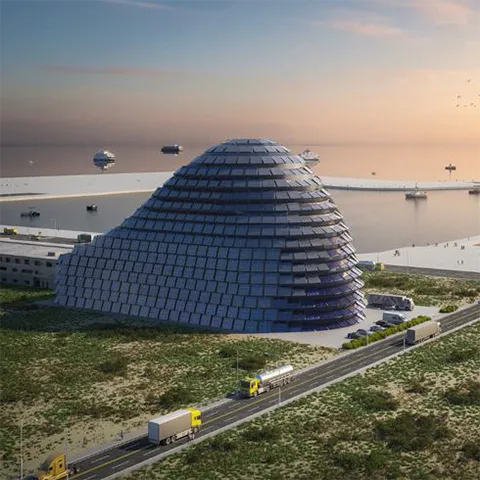
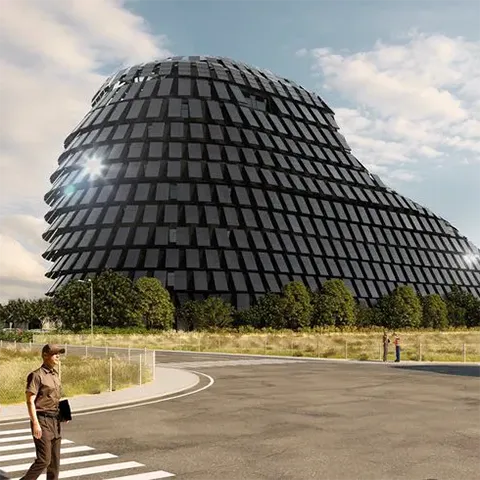
CREDITS TO MVRDV
Signed by the Dutch architecture firm MVRDV, the project Sun Rock represents an innovative architectural work conceived as an “energy production tool” and symbolizes Taiwan’s ambitions for a sustainable transition to renewable energies. Located in the coastal industrial park of Changhua, the building houses offices, maintenance workshops, and storage spaces for renewable energy components on an area of 4,000 square meters of photovoltaic panels. The rounded shape is designed to maximize solar exposure, with a slope to the south and a dome to the north that optimize energy absorption. Sun Rock is self-sufficient, generating nearly 1 million kilowatt-hours of clean energy per year, with the ambition to increase this capacity to 1.7 million kWh annually. In addition to its function as an energy generator, the building offers a multifunctional space with a Data Room to monitor Taipower operations, a rooftop terrace with trees, and a dome of solar panels. Sun Rock embodies the vision of a greener future, transforming solar energy into a tangible resource for sustainability.
The self-supporting glass facade, unique in China, reflects architectural innovation.
Internally, experiential spaces and an educational landscape promote shared learning. The building is committed to sustainability with photovoltaic elements and solar heat reduction techniques. A benchmark for future libraries combines advanced functionality with environmental responsibility.
Populus by Studio Gang | Denver, Colorado, USA

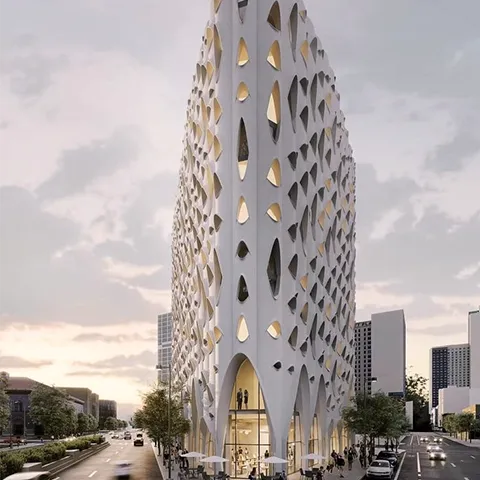
CREDITS TO STUDIO GANG
Designed by Studio Gang, Populus in Denver, Colorado, will be the first carbon-positive hotel in the United States, distinguishing itself as a pioneer of sustainable hospitality. Inspired by the Trembling Poplar trees, iconic to the American West, both in its exterior and its name, Populus pays tribute to nature. Jeanne Gang, the founder of Studio Gang, designed the hotel’s windows drawing inspiration from the growth of poplar trees, where the trunk, marked by dark eyes, sheds lower branches as it grows taller. This dynamic motif translates into the openings of the building, with each vertical bay indicating the width of a room. The structure caters to the needs of environmentally conscious travelers, aiming to be not only carbon-neutral but also carbon-positive, committing to offset carbon footprint. The structure will be built with low-emission concrete and recycled materials, reducing waste. Efficient systems, photovoltaic energy, and innovative technology will help contain consumption. The green roof, with local vegetation, will serve as a social space and event venue, naturally cooling the building.
Paper Island by Cobe | Copenhagen, Denmark
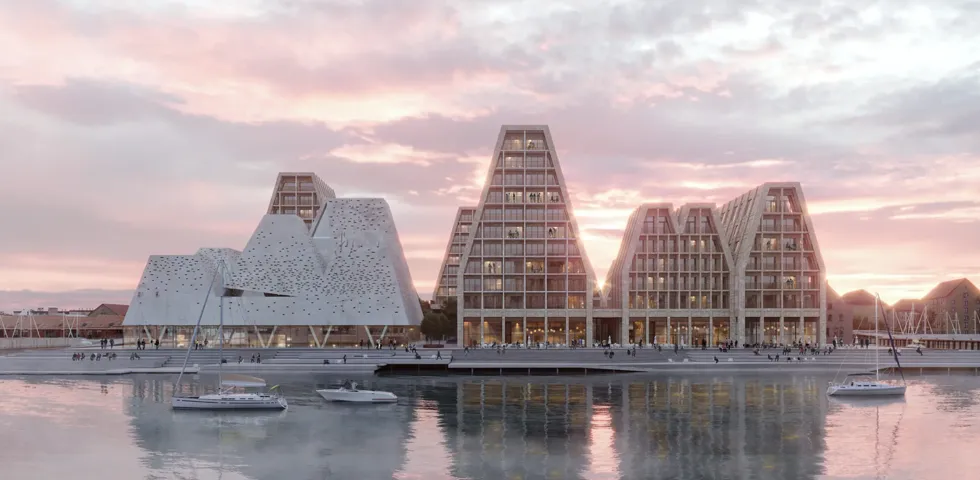
CREDITS TO COBE
The island of Christiansholm, known as “Paper Island,” is undergoing a transformation from a former industrial district to a new residential neighborhood thanks to the winning project of an international competition by the Cobe studio. The plan includes the creation of homes, commercial spaces, and “informal public functions” such as event spaces, galleries, and pools, all surrounded by a public promenade.
The project unfolds through pyramid-shaped forms that, inspired by the outlines outlined by the future master plan, will host the spaces of a cultural and wellness center. Connected by suspended walkways and paths along the water, these elements integrate into the surrounding environment. Along the waterfront and on various levels, water basins contribute to making the liquid element one of the central protagonists, giving the project a sense of continuity with nature.
The use of brick for the construction of the pyramids celebrates local tradition and Danish craftsmanship. The various laying patterns of the bricks will give the building different degrees of opacity, creating transparency effects that will vary depending on the seasons and times of the day. The tops of the pyramids will be cut to accommodate large skylights, allowing abundant natural light to penetrate the environment, in line with the tradition of Scandinavian architecture.
The Greenwich by Rafael Viñoly | New York, USA


CREDITS TO RAFAEL VINOLY
In 2019, construction began on a luxury residential tower designed by Rafael Viñoly at 125 Greenwich Street in New York. With 87 floors, the project, one of the most significant by the Uruguayan architect, joined his famous skyscraper, 432 Park Avenue. However, the construction site was suspended, leaving Lower Manhattan’s skyline incomplete.
Recently, it was announced that work would resume, and in honor of the deceased Viñoly, the tower was renamed “The Greenwich by Rafael Viñoly,” with completion expected in 2024. With 272 luxury residential units, ranging from studios to four-bedroom apartments, the residences will offer spectacular views of the Statue of Liberty, World Trade Center, and Hudson River.
With 2,500 square meters of amenities dedicated to leisure, health, and wellness, including a pool, SPA, and fitness area, the tower will offer breathtaking views over Manhattan from over 240 meters high. Román Viñoly, director of Rafael Viñoly Architects, emphasized his father’s love for people and curiosity about how the designed spaces could contribute to their well-being.
National Parliament of Benin by Kéré | Porto-Novo, Benin
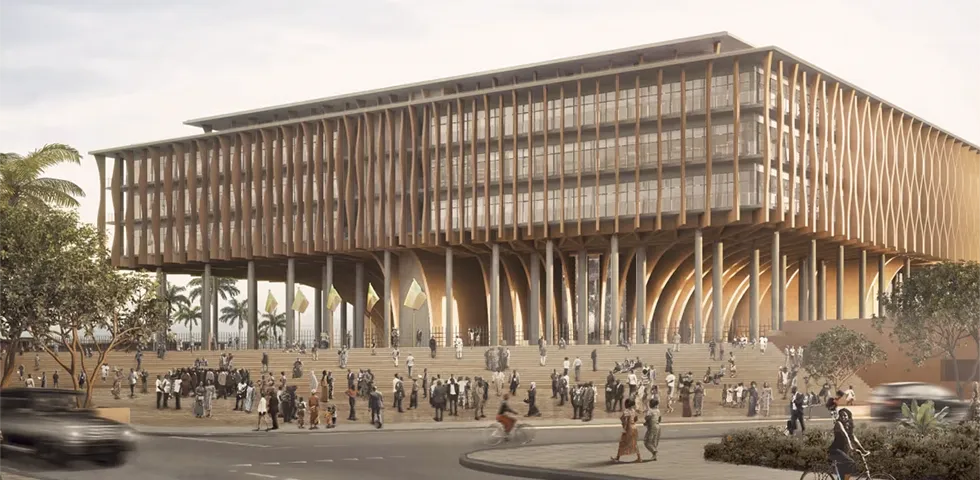
CREDITS TO KéRé
With the Kéré Architecture studio, the headquarters of the National Parliament of the Republic of Benin is coming to life, drawing inspiration from the iconic Palaver tree, under whose shade in West Africa people commonly gather to make community decisions.
The building, a manifesto of democratic values and the country’s identity, is conceived as a hollow tree trunk, promoting brightness, airflow, and human circulation. At the core of the project is the assembly hall on the ground floor, characterized by an evocative dynamic ceiling with exposed structural beams, reminiscent of tree branches.

